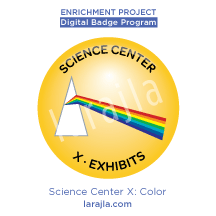 Experimenting with color in your activities / exhibits is another choice for your Science Center.
Experimenting with color in your activities / exhibits is another choice for your Science Center.
NOTE: Only general ideas are given for this theme. Be sure to explore ideas online or at your local library.
Steps
1. Color theory.
We see color all the time. From the color wheel to the rainbow, there are many ways we see colors. In addition, color has an effect on us. Explore more about color theory and its cultural implications.
2. White light.
The white light from a light bulb is actually a mixture of colors. You can see the colors when the light passes through a transparent substance like water or glass. This rainbow pattern is called a spectrum. Make a rainbow and discuss the seven colors we can see. Let your visitors make their own rainbows from white light.
3. Chromatography.
Using paper towel or coffee filter, make a black mark, line or shape with a permanent black marker. Dip it in water and watch the colors appear. You can do this with different brands of markers to see how fast the pigment is pulled through the paper.
4. Colored shadows.
www.exploratorium.edu/snacks/colored_shadows/index.html
Use the link above and experiment with colored shadows.
5. Colored flames.
Using a Bunsen burner or propane torch (and a volunteer), put varying chemicals into the flame to see color changes.
- Pink — lithium
- Orange — sodium, borax
- Purple — potassium
- Green — copper
- White sparks — magnesium
- Yellow sparks — iron filings
You can also do this experiment at a campfire.
6. Changing colors.
We’ve seen white carnations colored by food coloring. You can also do the same with celery. Since this takes a bit of time, you might want to show this in stages. Experiment with this as a possible exhibit or part of one.
7. Colors in a jar.
From making colors in a jar to how bleach affects the colors to even making a homemade “lava lamp”, you can contain the experiment to minimize the mess. Clear jars or even recycled clear bottles allow you to see the experiment. How might you use colors in a jar for an exhibit?
8. Fall color.
The most notable time we see color changes is in the fall when the leaves go from green to yellow, orange and red. Explore the changing colors of nature and create an exhibit around this.
9. Dye in nature.
You can use natural materials for fabric dye. Experiment with different plants, leaves, bark, hulls and more to create a variety of colors. Pioneers used these long ago. How might you combine pioneer ideas with your dyes?
10. See the light.
Color experiments often deal with light. See the “Science Center X: Light” for more colorful ideas.
11. Explore more!
Continue looking into even more ways to incorporate color into your Science Center.
Supplements
SUPP_Cards_Color.pdf
- Printable cards with colors and names, 2-sided, 16 cards
SUPP_Nature Dyes.pdf
- Dying with natural materials
SUPP_SCR_Colors.pdf
- Scramble: Colors
SUPP_WF_8 Colors.pdf
- Word Find: Basic 8 Colors
SUPP_WF_Colors.pdf
- Word Find: Color Fun!
SUPP_Exhibit Planner.pdf
- Exhibit Planner — Pre-planning and testing questions
SUPP_Scientific Inquiry.pdf
- Scientific Inquiry — Printables for use with any exhibit theme
Sites to Explore
- www.edutopia.org/blog/film-festival-color-science-philosophy-art
- www.metrofamilymagazine.com/June-2014/Simple-Science-Experiment-How-Our-Eyes-Perceive-Color
- www.two-daloo.com/10-colorful-science-experiments-for-kids
- www.pleasantestthing.com/2014/08/10-science-activities-will-amaze-kids.html
- www.stemmom.org/2012/08/light-and-color-lab.html
- www.stevespanglerscience.com/lab/experiments/category/color
- www.kidactivities.net/post/School-Age-Science-Center-Supply-List.aspx
- www.exploratorium.edu/explore
- www.livescience.com/41820-candy-chromatography.html
- teachbesideme.com/color-science-experiments-for-kids
- www.diynatural.com/natural-fabric-dyes
- pioneerthinking.com/crafts/natural-dyes
To download a PDF of this badge program, click here: EP_SCX_Color
Leave a Reply